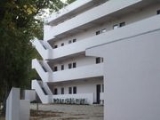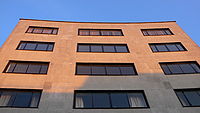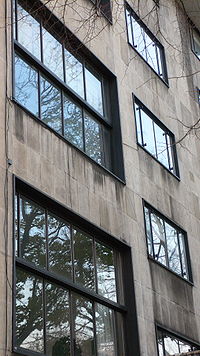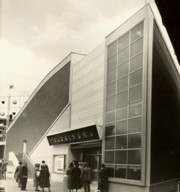
Wells Coates
Encyclopedia
Wells Wintemute Coates OBE
(December 17, 1895 – June 17, 1958) was an architect, designer and writer. He was, for most of his life, an ex-patriate Canadian
architect who is best known for his work in England. His most notable work is the Isokon building
in Hampstead, London
.
, Japan
on December 17, 1895 to Methodist missionaries Sarah Agnes Wintemute Coates (1864–1945) and Harper Havelock Coates (1865–1934).
The young man's desire to be an architect was inspired by his mother, who had herself studied architecture under Louis Sullivan
and planned one of the first missionary schools in Japan.
Coates spent his youth in the Far East, and voyaged around the world with his father in 1913. He served in World War I, first as a gunner and later as a pilot with the Royal Air Force. He attended the University of British Columbia
where he obtained a BA degree in May 1920 and a BSc degree in May 1922, and in October 1922 he registered at East London College where he studied engineering (obtaining a PhD in 1924). Among his first jobs in England was as a journalist and then with the design firm of Adams and Thompson in 1924. He established his own firm in 1928.
His childhood experiences in Japan would play an important role in his aesthetic sensibility that he brought to his architectural work, and this sensibility found a fitting outlet in the Modernist Movement, then current in Europe. He attended the 1933 Congrès International d'Architecture Moderne
(CIAM), which produced the famous Athens Charter
, and was one of the founders, with Maxwell Fry
, of the Modern Architectural Research Group (MARS)
, the British wing of CIAM.
 Wells embraced Le Corbusier
Wells embraced Le Corbusier
's architectural mantra that buildings should be 'machines for living' (machine à habiter). This ideal was best-reflected in his Isokon building
(also known as Lawn Road Flats), completed in 1934. Indeed, the architectural critic J. M. Richards suggested that he improved on Corbusier, coming "nearer to the machine à habiter than anything Corbusier ever designed". The building was compared to the exterior of an ocean liner by the novelist Agatha Christie
, who lived there for a time, so clean and striking was the design.
The apartment building was the brainchild of Jack and Molly Pritchard, who in 1931 established a design firm featuring Modernist architecture and furniture. With simple living spaces strongly influenced by Coates' Japanese experience, and including built-in Isokon furniture, Isokon was "an experiment in collective housing designed for left-wing intellectuals". It became a haven for Germans escaping Nazi persecution and hosted many famous personages including Christie, Walter Gropius
and Marcel Breuer
.
Isokon was ahead of its time: it won second place in Horizon Magazine's 'Ugliest Building Competition' in 1946, and would not be recognized as one of England's most important Modernist buildings for another decade. The building fell into disrepair by the 1990s but it changed ownership in 2001 and was fully restored by 2004.
 An inventive genius, Coates revelled in introducing new ideas in his work. Among his innovations was the '3-2' architectural plan
An inventive genius, Coates revelled in introducing new ideas in his work. Among his innovations was the '3-2' architectural plan
, where two living rooms on one side of the building are equivalent in height to three rooms on the other side, making two units vertically on three floors. He also designed the "D-handle", a simple door handle design commonly employed, for example, in Scandinavian furniture. In 1930 he designed a studio for the British Broadcasting Corporation, and among his technical designs was a microphone stand featuring an overhead counterbalanced arm that enabled the microphone to be moved to any part of the studio while remaining perfectly balanced. The design became a standard piece of equipment at the BBC. Coates also designed the distinctive round bakelite cabinets used by EKCO
for some of its radios during the 1930s.
The thirties were his most prolific era. The Isokon was immediately followed by Embassy Court
in Brighton
(1935) and 10 Palace Gate
, Kensington (1939). These were the only apartment buildings he would design. He also had several private home commissions. During World War II, he again served with the RAF, this time working on fighter aircraft development, for which he was later awarded an OBE
During World War II, he again served with the RAF, this time working on fighter aircraft development, for which he was later awarded an OBE
. Following the war, he, like some other well known architects including Gropius and Breuer (by then working in America), contributed to the British post-War housing effort by introducing an early scheme for modular housing he called Room Unit Production.
In 1949-50, he designed the building of the Telekinema
for the Festival of Britain
's South Bank Exhibition. This 400-seat, state-of-the-art cinema, specially designed to screen both film (including the first 3-dimensional films) and large-screen television, proved one of the most popular attractions of the South Bank Exhibition in the summer of 1951. Operated and programmed by the British Film Institute
, it re-opened as the National Film Theatre in October 1952, until its demolition in 1957 as the NFT was relocated a stone's throw away from its original site, under Waterloo Bridge.
 He also designed a remarkable boat, called the Wingsail. It had a rigid sail design mounted on a catamaran hull. Though he formed a company to market the design, it was not a success, as both the sail and the catamaran were ahead of their time.
He also designed a remarkable boat, called the Wingsail. It had a rigid sail design mounted on a catamaran hull. Though he formed a company to market the design, it was not a success, as both the sail and the catamaran were ahead of their time.
He is less well known for his planning work. In 1937, he undertook planning for a slum clearance in Britain (not implemented). In Canada (1952–54) he prepared plans for Iroquois New Town on the St. Lawrence River in eastern Ontario which were also not implemented (the design was awarded to others). He also prepared plans for a Toronto Island Redevelopment Project, and was a participant in the Project 58 urban redevelopment scheme for Vancouver.
with Walter Gropius but he was not happy there. He returned to Vancouver after two years, where he worked on Project 58. His last assignment was to design a monorail rapid transit system for Vancouver, dubbed the Monospan Twin-Ride System (MTRS). Once again, he was ahead of his time. The project was abandoned, but would be rejuvenated years later in another form known as SkyTrain
.
Wells Coates died of a heart attack
in Vancouver on June 17, 1958 at the age of 63.
Coates' daughter, Laura Cohn, published a biography of her father called The Door to a Secret Room (Aldershot: Scolar Press, 1999) ISBN 1-84014-695-8. There was also an earlier book, Wells Coates: a Monograph published in 1978. It was written by Sherban Cantacuzino and published by Gordon Fraser, London.
Order of the British Empire
The Most Excellent Order of the British Empire is an order of chivalry established on 4 June 1917 by George V of the United Kingdom. The Order comprises five classes in civil and military divisions...
(December 17, 1895 – June 17, 1958) was an architect, designer and writer. He was, for most of his life, an ex-patriate Canadian
Canada
Canada is a North American country consisting of ten provinces and three territories. Located in the northern part of the continent, it extends from the Atlantic Ocean in the east to the Pacific Ocean in the west, and northward into the Arctic Ocean...
architect who is best known for his work in England. His most notable work is the Isokon building
Isokon building
The Isokon building in Lawn Road, Hampstead, London is a concrete block of 34 flats designed by architect Wells Coates for Molly and Jack Pritchard. They were built between 1933 and 1934 as an experiment in communal living. Most of the flats had very small kitchens as there was a large communal...
in Hampstead, London
London
London is the capital city of :England and the :United Kingdom, the largest metropolitan area in the United Kingdom, and the largest urban zone in the European Union by most measures. Located on the River Thames, London has been a major settlement for two millennia, its history going back to its...
.
Early years
The oldest of six children, Wells Coates was born in TokyoTokyo
, ; officially , is one of the 47 prefectures of Japan. Tokyo is the capital of Japan, the center of the Greater Tokyo Area, and the largest metropolitan area of Japan. It is the seat of the Japanese government and the Imperial Palace, and the home of the Japanese Imperial Family...
, Japan
Japan
Japan is an island nation in East Asia. Located in the Pacific Ocean, it lies to the east of the Sea of Japan, China, North Korea, South Korea and Russia, stretching from the Sea of Okhotsk in the north to the East China Sea and Taiwan in the south...
on December 17, 1895 to Methodist missionaries Sarah Agnes Wintemute Coates (1864–1945) and Harper Havelock Coates (1865–1934).
The young man's desire to be an architect was inspired by his mother, who had herself studied architecture under Louis Sullivan
Louis Sullivan
Louis Henri Sullivan was an American architect, and has been called the "father of skyscrapers" and "father of modernism" He is considered by many as the creator of the modern skyscraper, was an influential architect and critic of the Chicago School, was a mentor to Frank Lloyd Wright, and an...
and planned one of the first missionary schools in Japan.
Coates spent his youth in the Far East, and voyaged around the world with his father in 1913. He served in World War I, first as a gunner and later as a pilot with the Royal Air Force. He attended the University of British Columbia
University of British Columbia
The University of British Columbia is a public research university. UBC’s two main campuses are situated in Vancouver and in Kelowna in the Okanagan Valley...
where he obtained a BA degree in May 1920 and a BSc degree in May 1922, and in October 1922 he registered at East London College where he studied engineering (obtaining a PhD in 1924). Among his first jobs in England was as a journalist and then with the design firm of Adams and Thompson in 1924. He established his own firm in 1928.
His childhood experiences in Japan would play an important role in his aesthetic sensibility that he brought to his architectural work, and this sensibility found a fitting outlet in the Modernist Movement, then current in Europe. He attended the 1933 Congrès International d'Architecture Moderne
Congrès International d'Architecture Moderne
The Congrès internationaux d'architecture moderne – CIAM was an organization founded in 1928 and disbanded in 1959, responsible for a series of events and congresses arranged around the world by the most prominent architects of the time, with the objective of spreading the principles of the Modern...
(CIAM), which produced the famous Athens Charter
Athens Charter
The Athens Charter, or Charte d'Athènes was a document about urban planning published by the Swiss architect, Le Corbusier in 1943. The work was based upon Le Corbusier’s Ville Radieuse book of 1935 and urban studies undertaken by the Congrès International d'Architecture Moderne in the early...
, and was one of the founders, with Maxwell Fry
Maxwell Fry
Edwin Maxwell Fry, CBE, RA, FRIBA, FRTPI, known as Maxwell Fry , was an English modernist architect of the middle and late 20th century, known for his buildings in Britain, Africa and India....
, of the Modern Architectural Research Group (MARS)
MARS Group
The Modern Architectural Research Group, or MARS Group, was a British architectural think tank founded in 1933 by several prominent architects and architectural critics of the time involved in the British modernist movement...
, the British wing of CIAM.
Role as a Modernist

Le Corbusier
Charles-Édouard Jeanneret, better known as Le Corbusier , was a Swiss-born French architect, designer, urbanist, writer and painter, famous for being one of the pioneers of what now is called modern architecture. He was born in Switzerland and became a French citizen in 1930...
's architectural mantra that buildings should be 'machines for living' (machine à habiter). This ideal was best-reflected in his Isokon building
Isokon building
The Isokon building in Lawn Road, Hampstead, London is a concrete block of 34 flats designed by architect Wells Coates for Molly and Jack Pritchard. They were built between 1933 and 1934 as an experiment in communal living. Most of the flats had very small kitchens as there was a large communal...
(also known as Lawn Road Flats), completed in 1934. Indeed, the architectural critic J. M. Richards suggested that he improved on Corbusier, coming "nearer to the machine à habiter than anything Corbusier ever designed". The building was compared to the exterior of an ocean liner by the novelist Agatha Christie
Agatha Christie
Dame Agatha Christie DBE was a British crime writer of novels, short stories, and plays. She also wrote romances under the name Mary Westmacott, but she is best remembered for her 66 detective novels and 14 short story collections , and her successful West End plays.According to...
, who lived there for a time, so clean and striking was the design.
The apartment building was the brainchild of Jack and Molly Pritchard, who in 1931 established a design firm featuring Modernist architecture and furniture. With simple living spaces strongly influenced by Coates' Japanese experience, and including built-in Isokon furniture, Isokon was "an experiment in collective housing designed for left-wing intellectuals". It became a haven for Germans escaping Nazi persecution and hosted many famous personages including Christie, Walter Gropius
Walter Gropius
Walter Adolph Georg Gropius was a German architect and founder of the Bauhaus School who, along with Ludwig Mies van der Rohe and Le Corbusier, is widely regarded as one of the pioneering masters of modern architecture....
and Marcel Breuer
Marcel Breuer
Marcel Lajos Breuer , was a Hungarian-born modernist, architect and furniture designer of Jewish descent. One of the masters of Modernism, Breuer displayed interest in modular construction and simple forms.- Life and work :Known to his friends and associates as Lajkó, Breuer studied and taught at...
.
Isokon was ahead of its time: it won second place in Horizon Magazine's 'Ugliest Building Competition' in 1946, and would not be recognized as one of England's most important Modernist buildings for another decade. The building fell into disrepair by the 1990s but it changed ownership in 2001 and was fully restored by 2004.
Later achievements

Architectural plan
An architectural plan is a plan for architecture, and the documentation of written and graphic descriptions of the architectural elements of a building project including sketches, drawings and details.- Overview :...
, where two living rooms on one side of the building are equivalent in height to three rooms on the other side, making two units vertically on three floors. He also designed the "D-handle", a simple door handle design commonly employed, for example, in Scandinavian furniture. In 1930 he designed a studio for the British Broadcasting Corporation, and among his technical designs was a microphone stand featuring an overhead counterbalanced arm that enabled the microphone to be moved to any part of the studio while remaining perfectly balanced. The design became a standard piece of equipment at the BBC. Coates also designed the distinctive round bakelite cabinets used by EKCO
EKCO
EKCO from Eric Kirkham Cole Limited was a British electronics company producing radio and television sets from 1924.Expanding into plastic production for its own use, Ekco Plastics produced both radio cases and later domestic plastic products; the plastics company became Lin Pac Mouldings...
for some of its radios during the 1930s.
The thirties were his most prolific era. The Isokon was immediately followed by Embassy Court
Embassy Court
Embassy Court is a radical Grade II* listed residential building in the city of Brighton and Hove, England. Designed by Wells Coates, it was one of the first modernist buildings to be constructed in Britain and also featured the first penthouse suite anywhere in the country...
in Brighton
Brighton
Brighton is the major part of the city of Brighton and Hove in East Sussex, England on the south coast of Great Britain...
(1935) and 10 Palace Gate
10 Palace Gate
10 Palace Gate is an apartment block in London’s Kensington area, designed by Wells Coates. Completed in 1939 for the builder Randall Bell, it is a Modernist structure in the tradition of Le Corbusier and Walter Gropius, both of whom had influence on Coates’ work...
, Kensington (1939). These were the only apartment buildings he would design. He also had several private home commissions.

Order of the British Empire
The Most Excellent Order of the British Empire is an order of chivalry established on 4 June 1917 by George V of the United Kingdom. The Order comprises five classes in civil and military divisions...
. Following the war, he, like some other well known architects including Gropius and Breuer (by then working in America), contributed to the British post-War housing effort by introducing an early scheme for modular housing he called Room Unit Production.
In 1949-50, he designed the building of the Telekinema
Telekinema
The Telecinema was a small cinema built specially for the Festival of Britain's London South Bank Exhibition in the summer of 1951. It was situated between Waterloo Station and the Royal Festival Hall....
for the Festival of Britain
Festival of Britain
The Festival of Britain was a national exhibition in Britain in the summer of 1951. It was organised by the government to give Britons a feeling of recovery in the aftermath of war and to promote good quality design in the rebuilding of British towns and cities. The Festival's centrepiece was in...
's South Bank Exhibition. This 400-seat, state-of-the-art cinema, specially designed to screen both film (including the first 3-dimensional films) and large-screen television, proved one of the most popular attractions of the South Bank Exhibition in the summer of 1951. Operated and programmed by the British Film Institute
British Film Institute
The British Film Institute is a charitable organisation established by Royal Charter to:-Cinemas:The BFI runs the BFI Southbank and IMAX theatre, both located on the south bank of the River Thames in London...
, it re-opened as the National Film Theatre in October 1952, until its demolition in 1957 as the NFT was relocated a stone's throw away from its original site, under Waterloo Bridge.

He is less well known for his planning work. In 1937, he undertook planning for a slum clearance in Britain (not implemented). In Canada (1952–54) he prepared plans for Iroquois New Town on the St. Lawrence River in eastern Ontario which were also not implemented (the design was awarded to others). He also prepared plans for a Toronto Island Redevelopment Project, and was a participant in the Project 58 urban redevelopment scheme for Vancouver.
Final years in Canada
Coates began coming back to Canada in the early 1950s, about the time of the Iroquois project, finally settling there in 1957. In 1955 and 1956, he taught at the Graduate School of Design at HarvardHarvard University
Harvard University is a private Ivy League university located in Cambridge, Massachusetts, United States, established in 1636 by the Massachusetts legislature. Harvard is the oldest institution of higher learning in the United States and the first corporation chartered in the country...
with Walter Gropius but he was not happy there. He returned to Vancouver after two years, where he worked on Project 58. His last assignment was to design a monorail rapid transit system for Vancouver, dubbed the Monospan Twin-Ride System (MTRS). Once again, he was ahead of his time. The project was abandoned, but would be rejuvenated years later in another form known as SkyTrain
SkyTrain (Vancouver)
SkyTrain is a light rapid transit system in Metro Vancouver, British Columbia, Canada. SkyTrain has of track and uses fully automated trains on grade-separated tracks, running mostly on elevated guideways, which helps SkyTrain to hold consistently high on-time reliability...
.
Wells Coates died of a heart attack
Myocardial infarction
Myocardial infarction or acute myocardial infarction , commonly known as a heart attack, results from the interruption of blood supply to a part of the heart, causing heart cells to die...
in Vancouver on June 17, 1958 at the age of 63.
Further reading
The University of East Anglia Library in Norwich has materials relating to his life and work. A list of the holdings is available on the World Wide Web. Additional reference materials from the CIAM period are held at the CIAM Belgian Section of the Getty Research Institute.Coates' daughter, Laura Cohn, published a biography of her father called The Door to a Secret Room (Aldershot: Scolar Press, 1999) ISBN 1-84014-695-8. There was also an earlier book, Wells Coates: a Monograph published in 1978. It was written by Sherban Cantacuzino and published by Gordon Fraser, London.

